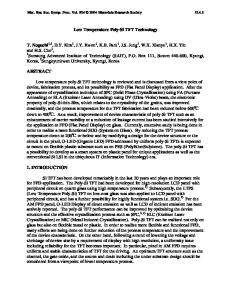Low Temperature Polycrystalline Si TFTs Fabricated with Directionally Crystallized Si Film
- PDF / 2,641,340 Bytes
- 6 Pages / 612 x 792 pts (letter) Page_size
- 63 Downloads / 279 Views
Low Temperature Polycrystalline Si TFTs Fabricated with Directionally Crystallized Si Film Y.H. Jung, J.M. Yoon, M.S. Yang, W.K. Park, H.S. Soh, Anyang Laboratory, LG-Philips LCD Co. Ltd, Dongan-gu, Anyang-shi, Kyungki-do, KOREA; H.S. Cho, A.B. Limanov, and J.S. Im, Program in Materials Science, Columbia University, New York, NY 10027 ABSTRACT The comparison of TFTs fabricated on films processed by conventional excimer laser annealing (ELA) and sequential lateral solidification (SLS) demonstrates the dependence of the device characteristics on the microstructure of the device channel region. We report the performance characteristics of non-self-aligned coplanar n- and p-channel low temperature TFTs fabricated on 1000-Å-thick films on Corning 1737 glass substrates that were directionally solidified using SLS. The devices were aligned so that the grain boundaries were parallel to the direction of the source-drain current flow. These results were compared with those obtained from devices fabricated on conventional ELA-processed polycrystalline Si films (with average grain size of ∼3000 Å) with identical methods. The values for channel mobility obtained from the SLS TFTs are ∼370 cm2/Vsec for n-channel and ∼140 cm2/Vsec for p-channel devices, compared to ∼100 and ∼60 respectively for ELA TFTs. Other device characteristics of SLS TFTs were Ion/Ioff > 107 at Vd=0.1V, and subthreshold slopes less than 0.5V/dec. We further discuss the physical implications of the results and present additional details of the devices. INTRODUCTION In order to manufacture TFT-LCD panels incorporating both gate drivers and data drivers, TFT performance is required to exceed that obtained by conventional excimer laser annealing (ELA) methods. The channel mobilities obtained for TFTs fabricated on conventionally crystallized polycrystalline Si films are in the range of ∼140 cm2/Vsec for n-channel TFTs and ∼60 cm2/Vsec for p-channel TFTs; these are sufficient for application in simple circuits such as gate drivers, but insufficient for more complicated circuits such as data drivers. For this reason, it is required that separate modules for data driver IC's - which are fabricated using conventional monolithic semiconductor processes - be attached to most polycrystalline Si TFT-LCD panels developed to date, requiring an additional step in the manufacturing process. It is therefore desirable to incorporate all circuits involved in the operation of the panel on the panel, and furthermore realize incorporation of an entire integrated system on the same panel. For this, TFTs with better electrical properties must be developed. Currently, one of the most significant frontiers in the development of electrically superior TFTs is the improvement of the microstructure in the active channel region. It is well known that the presence of grain boundaries detrimentally affects the carrier mobility in a semiconductor film, due to carrier trapping at the dangling bonds and formation of a potential barrier at the grain boundary [1]. The most ideal material for the
Data Loading...











